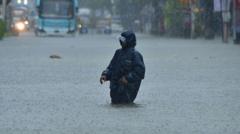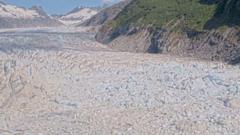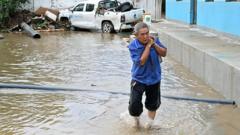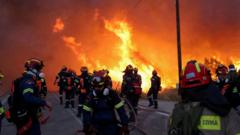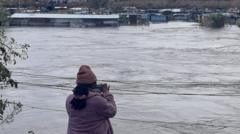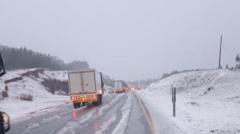The Swiss resort of Zermatt is isolated, while the French resort of Tignes advises residents to stay indoors due to heavy snow and high avalanche risk. Infrastructure in the region is severely impacted, leading to power outages and transportation blockages. Simultaneously, northern Italy faces flooding and rising river levels, prompting safety concerns.
Alpine Resorts Hit by Severe Weather: Snow and Flooding Disrupt Travel

Alpine Resorts Hit by Severe Weather: Snow and Flooding Disrupt Travel
Heavy snowfalls in the Alps are causing significant disruptions for travelers and residents in Switzerland and France, with avalanche risks escalating.
Heavy snow has caused major upheaval in several Alpine resorts across Switzerland and France, coinciding with the onset of the Easter holiday. The iconic Swiss ski destination, Zermatt, found itself completely cut off, leaving residents and tourists instructed to remain indoors. Mayor Serge Revial of the French resort Tignes expressed profound concern over public safety, labeling the avalanche risk as significant after over a meter of snow fell on the area.
While heavy snowfall in the Alps is not unprecedented in April, this particular weather event has resulted in substantial logistical issues. The Savoie region of eastern France experienced widespread power outages, impacting thousands of homes. In Switzerland, key traffic routes such as the Simplon Pass into Italy and the Great St Bernard Tunnel were forced to close, further complicating travel plans for vacationing skiers.
After severe weather knocked out power in the southern cantons of Valais and Bernese Oberland, tourists aiming for a ski getaway faced considerable disruptions. Zermatt, specifically, saw transport routes to the resort cut off, accompanied by reports of significant power outages and mobile network failures throughout Thursday. Swiss media detailed scenes of long queues forming outside the lone supermarket that remained operational.
Authorities utilized the Alertswiss app to alert the public to avalanche risks and falling tree hazards in Valais, coupled with transport disruptions. Schools across the city of Sion were also instructed to close for the day. With Easter travel plans dashed, potential visitors were encouraged to postpone trips until Saturday, with local police advising residents to stay indoors wherever feasible.
Further complicating the situation, the Aosta Valley in northwest Italy also reported power outages affecting 37 municipalities. A bridge collapse in nearby Biella further highlighted the region's infrastructure vulnerabilities. In stark contrast, heavy rainfall was the most pressing issue in this area, leading to overflowing rivers, including the Po, which was particularly concerning ahead of anticipated peak levels.
Amid rising floodwaters, reports detailed a tragic incident involving a 92-year-old man presumed drowned in his home in Monteu da Po. Residents are grappling with incessant rain, with Manuela, a local resident, describing the combined chaos as "non-stop" for days, now showing signs of a brief respite. Local authorities implemented red alerts in several valleys to manage ongoing safety risks as river levels threatened to rise dramatically.
While heavy snowfall in the Alps is not unprecedented in April, this particular weather event has resulted in substantial logistical issues. The Savoie region of eastern France experienced widespread power outages, impacting thousands of homes. In Switzerland, key traffic routes such as the Simplon Pass into Italy and the Great St Bernard Tunnel were forced to close, further complicating travel plans for vacationing skiers.
After severe weather knocked out power in the southern cantons of Valais and Bernese Oberland, tourists aiming for a ski getaway faced considerable disruptions. Zermatt, specifically, saw transport routes to the resort cut off, accompanied by reports of significant power outages and mobile network failures throughout Thursday. Swiss media detailed scenes of long queues forming outside the lone supermarket that remained operational.
Authorities utilized the Alertswiss app to alert the public to avalanche risks and falling tree hazards in Valais, coupled with transport disruptions. Schools across the city of Sion were also instructed to close for the day. With Easter travel plans dashed, potential visitors were encouraged to postpone trips until Saturday, with local police advising residents to stay indoors wherever feasible.
Further complicating the situation, the Aosta Valley in northwest Italy also reported power outages affecting 37 municipalities. A bridge collapse in nearby Biella further highlighted the region's infrastructure vulnerabilities. In stark contrast, heavy rainfall was the most pressing issue in this area, leading to overflowing rivers, including the Po, which was particularly concerning ahead of anticipated peak levels.
Amid rising floodwaters, reports detailed a tragic incident involving a 92-year-old man presumed drowned in his home in Monteu da Po. Residents are grappling with incessant rain, with Manuela, a local resident, describing the combined chaos as "non-stop" for days, now showing signs of a brief respite. Local authorities implemented red alerts in several valleys to manage ongoing safety risks as river levels threatened to rise dramatically.

